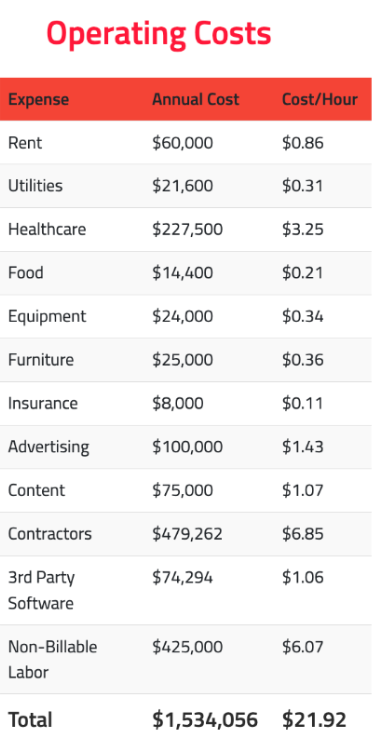Search Engine Optimization
People follow Clarity NOT Character. As a leader, your ability to understand what matters to your business and how to measure it is critical if you want to be effective. Your character is paramount, but will only get you so far.
What’s Covered in this Article
- How much do people pay you for your product/service
- How much does it cost you to deliver your product/service
- How much cash do you have in the bank
Data-driven digital marketing is table stakes at this stage in the game. Sadly, this is probably one of the most overused and poorly executed philosophies today.┬Ā
HereŌĆÖs what I mean. Digital marketers and digital agencies alike love to plaster data-driven decisions into job descriptions, marketing copy, and best practice blogs. The problem I see is that when it comes to putting that into practice, hereŌĆÖs what happens:
- Digital Marketer puts together a report and a slide deck outlining the traffic, conversion, and lead generation trends vs the previous period, speaks to why the trends are what they are, and then recommends next steps.
- Manager or Client responds with something to the tune of ŌĆ£our development queue is full for the next 3 months, we will need a business case to get these initiatives into an upcoming sprint.ŌĆØ
- Digital Marketer gets frustrated that their work isnŌĆÖt being prioritized, struggles to interpret what kind of business case that manager/client needs to see, presents a haphazard business case, and then waits, hoping that their project makes it through.
In the business context, making data-driven decisions should be defined as something like this, ŌĆ£Data-driven decisions also need to be business-driven decisions.ŌĆØ
Unfortunately, the clumsy interaction I described above plagues digital marketers, and marketers at large, but it doesnŌĆÖt have to be this way. Hopefully this article helps marketers like you┬Ā go from data reporter to data-driven business leader.
Knowing what matters
In marketing, itŌĆÖs all about knowing your client and measuring what matters most to them. One of the points from my recent post about the keys to being a great marketing leader is to ŌĆ£know your funnel.ŌĆØ A slight variation on this is to say that you need to understand the economic engine that drives the business. If you didnŌĆÖt go to business school or simply tried not to fall asleep in managerial accounting like me, then it can feel daunting to hear a phrase like ŌĆ£understand your economic engine.ŌĆØ
HereŌĆÖs why this shouldnŌĆÖt scare you. All you need to know to understand your economic engine is these three things:
- How much do people pay you for your product/service?
- How much does it cost you to deliver that product/service?
- How much money do you have in the bank?
Pretty simple, but the devil is in the details, so letŌĆÖs break this down.
How much do people pay you for your product/service?
If youŌĆÖre a marketer who does SEO, itŌĆÖs really easy to obsess over keyword rankings and organic traffic trends. If youŌĆÖre an email marketer, itŌĆÖs very easy to mull over click-thru-rate and open rate data for hours. What is true in both of these cases is that itŌĆÖs also very easy to lose sight of the big picture.┬Ā
When it comes down to it, the only thing that matters for SEO and email marketers is this: did my work create more revenue for the company? If you donŌĆÖt know how much people are paying for your services, then ask!┬Ā
Side note: if youŌĆÖre the leader on your team and you havenŌĆÖt provided this context to your team, then start now. As an entrepreneur and small business owner, IŌĆÖm always desiring for my team to ŌĆ£act like owners.ŌĆØ If you want your team to do the same, get them the data they need to do so, starting with how you make money.
How much does your product/service cost?
I can imagine that as you read this, similar to how it feels while IŌĆÖm writing it, it seems like child’s play. I mean weŌĆÖre talking about margin ŌĆö the difference between revenue and cost. It doesnŌĆÖt get much more simple than that. But, IŌĆÖve watched too many marketers miss the forest through the trees when it comes to true data-driven marketing.
Knowing what people pay you AND knowing how much your product/service costs to deliver, gives you the data you need to understand how much youŌĆÖre willing to spend to earn a new customer. Note: this information might not be available in every company ŌĆö┬Āyou may only get a target CPA or an average sale KPI, but the principle still applies.┬Ā
Now, itŌĆÖs time to take it a level deeper. For my math and finance fans, thank you for making it this far and not laughing at me. For my digital marketing folks who have been coasting on impressions and visits, now is the time to really dig in.
Here is the secret: If you want to be a true data-driven marketer, there are two concepts you must master. The first is fully-baked cost of delivering a product/service. The second IŌĆÖll talk about in the next section.
Fully-baked cost of delivering a service was first introduced to me by my friend Nick Eubanks in one of his articles about why his minimum engagement is $30k. So thanks Nick for the assist here.
What is it
Fully loaded cost of delivering a service, at least in my personal definition, means understanding how to allocate all the other costs of running a company into the per unit economics of your business.
What does that mean
Borrowing NickŌĆÖs breakdown for a minute, here is how he mapped out the fully-baked cost for running his agency.

In the image you see, Nick broke down the annual cost for all the overhead and other expenses that go into running an agency business. Notice especially the non-billable labor line item at the bottom (this is all the time that his team spends that isnŌĆÖt billable to a client ŌĆö aka ŌĆö management, leadership, internal strategy meetings, etc).
He then divided those costs by the total amount of time available on his team to determine how that cost gets distributed at an ŌĆ£hourly cost.ŌĆØ By totaling up the hourly costs, youŌĆÖre able to add $21.92 to the cost of your labor, preventing you from giving away all of your margin by pricing too low.
For every business, these types of costs are critical to understand. In e-commerce, knowing your fully loaded costs is critical to managing your margins, and from that,┬Ā your cash flow.
As a marketer, itŌĆÖs your job to push for this level of data. If you donŌĆÖt, then you are setting yourself up for frustration and failure. To crystalize the point, letŌĆÖs imagine two different leaders who you might be making a business case to.
Leader 1: The leader who doesnŌĆÖt know this and is actually in over their head. This type of leader can often be very nervous to make a decision (mostly because theyŌĆÖre subconsciously aware that they donŌĆÖt know how to validate a good decision). As a marketer reporting to this person, if you donŌĆÖt come to them with a business case that understands revenue and fully baked costs, no matter now much sense your idea makes, this leader is going to struggle to pull the trigger and therefore be slow to approve your initiatives. Your job here is to help them help you.
Leader 2: The leader who really knows their stuff. This type of leader is never going to accept a half baked idea. If you havenŌĆÖt done all of your homework to truly map out the business case, then your idea is dead before you even pitched it. It might feel demanding to satisfy this type of leader, but itŌĆÖs your job to make sure that your good ideas are pushed through by stepping up to the demands they have. Know your numbers, and then even your mediocre ideas might get through just because the risks and rewards are clear from the jump.┬Ā
Bottom line ŌĆö as marketers, I implore you to step up. ItŌĆÖs too easy for marketing to get labeled as a cost or a nice-to-have on the P&L. IŌĆÖm biased, but I believe marketing is the glue of most all organizations, so letŌĆÖs make sure our business cases stick!
How much money is in the bank?
I couldnŌĆÖt finish this post without jumping fully into the deep end, so letŌĆÖs do this. How much money is in the bank? Such a simple question, but a very vulnerable one. Having bootstrapped my company for 8 years, I know what itŌĆÖs like to stare down the barrel of missing payroll and have to figure out a plan. I can still remember when a friend and advisor told me very early in my days as an owner, ŌĆ£Alex, you need to grow some hair on your chest.ŌĆØ as I somewhat panicked to him about not making a payroll.┬Ā
I was really frustrated at the time, but in reflection, it was what I needed to hear in that moment ŌĆö and it might be what you need to hear going into this final section. Talking about money is difficult. Nobody likes it, most people avoid it, but the best embrace the reality of it and learn not to fear it.┬Ā
When marketers donŌĆÖt know how much cash is in the bank, we have no way to understand the risk we are asking leadership to take when we propose a new investment. IŌĆÖve always been a pretty transparent leader, sometimes to a fault, but it has allowed me to see how people respond to knowing how much money is in the bank. IŌĆÖve seen what happens when marketers/leaders donŌĆÖt respond well ŌĆö they generally do one of two things:
- They back down and donŌĆÖt push for something they believe in. Why? In my opinion, itŌĆÖs often because theyŌĆÖre so afraid of the 10% chance that it could fail, that they wonŌĆÖt risk their reputation despite the 90% chance itŌĆÖs good for the company.
- They enter into a spin cycle of searching for the silver bullet, wasting hours and hours looking for a way to make their proposal foolproof, but the problem is, nothing is foolproof. So instead of trusting their gut and their research, they waste their time and the companyŌĆÖs time on a foolŌĆÖs errand for the perfect plan.
It feels kind of harsh writing this, and I hate it when I believe that IŌĆÖm saying or writing something harsh, but I felt like this had to be in here. Marketers have to be able to face the pucker factor. Can you stare the bank account in the face, with a full understanding of your economic engine, and still make a recommendation? If the answer isnŌĆÖt yes, then you are simply rolling the dice, and eventually the odds turn, and you will crap out.
Conclusion
Our purpose at Grit is to cultivate virtuous leaders who change the world. Often this can be interpreted as kind of fluffy or pie-in-the-sky type of purpose statement, but what we talk about a lot internally is that if you want to be a leader that changes the world, effectiveness is required.┬Ā
Similarly, our mission is to strengthen brands by driving profitable growth. In order to fulfill this mission, you must measure what matters and know what that is. Which just to recap is simple (but not easy). You must know these three things:
- How much do people pay you for your product/service?
- How much does it cost you to deliver that product/service?
- How much money do you have in the bank?
If you dig into these three things, face your fears, and trust your work, I can promise you that your projects will end up in the development queue more often than not!
As always, I would love to hear other thoughts, reactions, or comments. Feel free to leave them in the comments below or shoot me an email at alex@thegritgroup.io. IŌĆÖm happy to grab a drink ŌĆö virtual or in-person ŌĆö to talk shop about leadership and marketing!












